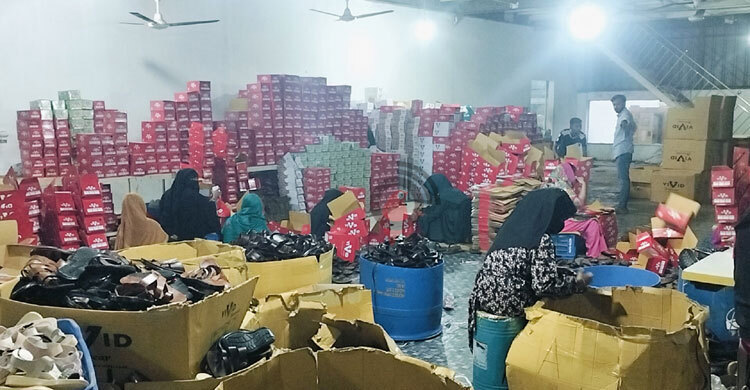
Nestled along the bank haor in Kishoreganj, Bhairab has emerged as a thriving hub for Bangladesh’s SMEs featuring footwear. With an annual sales volume of around Tk 2,000 crore, this sector employs over 1,50,000 workers across approximately 7,000 units, ranging from small cottage industry to large export-oriented units. However, despite its success, the industry faces challenges such as a lack of financing and skilled labour, which threaten to hinder its growth.
A journey of growth
The footwear industry in Bhairab began its journey in 1989, with the establishment of the first factory in the Bhairab Upazila Parishad area. Over the past three decades, it has grown exponentially, spreading across a 10-kilometer radius and becoming the largest footwear manufacturing centre in the country. Today, Bhairab is not only meeting local demand but also exporting its products to international markets, including the Middle East, Malaysia, and Japan.
The industry’s growth has been fuelled by Bhairab’s strategic location, with excellent road, rail, and water connections to Dhaka, Chittagong, and other parts of the country. The availability of cheap labour and a robust communication network has further accelerated its expansion. What started with the production of simple sandals has now evolved into a diverse range of footwear, including loafers, sneakers, formal shoes, belts, and wallets.
A flourishing ecosystem
Bhairab’s footwear industry has created a vibrant ecosystem, supporting over 5,00,000 people directly and indirectly. This includes workers in raw material supply, packaging, and other ancillary services. The region boasts six major wholesale markets and more than 50 footwear industrial villages, spread across areas like Bhairab Bazar, Kamalpur, Bhairabpur, Gachtalaghat, Shambhupur, and Shimulkandi.
Around 40-50 large factories equipped with modern machinery cater to export demands, while thousands of smaller units continue to produce footwear manually. These factories supply products to renowned local brands such as Apex, Bata, Bay, Pegasus, and Afzal Shoes. Additionally, private initiatives have enabled the export of footwear worth hundreds of crores of taka annually.
Challenges and opportunities
Despite its success, the industry faces significant challenges. Miaur Uddin Apu, owner of Tahmina Sandal Factory, highlighted the impact of rising raw material costs, exacerbated by fluctuations in the dollar market and global events like the Russia-Ukraine war. "Most raw materials are imported from China, and their prices are constantly increasing. Power shortages further hamper production," he said.
Zia Uddin, owner of Sajeeb Sandal Shoe Factory, emphasised the need for skilled labour.
"Workers lack knowledge of modern technology. Providing training could significantly boost production," he added.
Samiullah Sunny, a partner at Beijing PO Foot Factory, echoed this sentiment, pointing out the difficulties in importing essential chemicals for modern footwear production due to dollar rate fluctuations.
A call for support
Baharul Alam Bachchu, General Secretary of the Bhairab PO Foot Industry Association, stressed the need for government support to unlock the sector’s full potential. "Bhairab’s footwear is of high quality, attracting buyers from across the country. However, traders struggle to increase production due to a lack of capital. Easy-term loans could transform this sector into a major export-oriented industry," he said.
Zahidul Haque Javed, Vice President of the Bhairab Chamber of Commerce and Industry, highlighted the industry’s promise. "Bhairab’s footwear sector meets national demand and has begun exporting. However, most workers are unskilled. Training programs could significantly enhance productivity," he noted.
A bright future
Bhairab’s footwear industry stands as a testament to the resilience and ingenuity of local entrepreneurs. With the right support—be it financial assistance, skill development, or infrastructure improvements—this sector has the potential to become a cornerstone of Bangladesh’s export economy. As Bhairab’s shoes step onto the global stage, they carry with them the hopes of a community striving for prosperity and growth.

